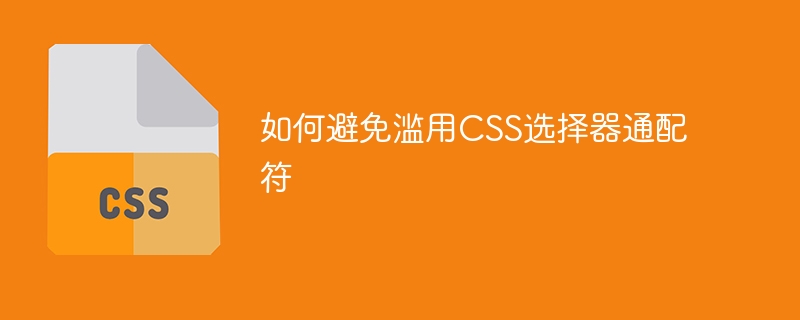Home >Web Front-end >CSS Tutorial >How to use CSS selector wildcards correctly
How to use CSS selector wildcards correctly
- PHPzOriginal
- 2023-12-26 17:04:321138browse

How to avoid abusing CSS selector wildcards
CSS (Cascading Style Sheets) is a language used for web design and styling. A CSS selector wildcard is a special selector that matches all attributes of a specified element and its child elements. When using CSS selectors, misuse of wildcards can lead to overly broad selectors, poor performance, and less maintainable code. This article explains how to avoid abusing CSS selector wildcards and provides specific code examples.
- Use more specific selectors
The wildcard selector (*) can match any element on the page, but such a selector is very broad and will select every element on the page. To avoid unnecessary selections, you should try to use more specific selectors. For example, if you only want to select a specific element with the class name "example" on the page, you can use the selector [class="example"].
[class="example"] {
/* 样式设置 */
}- Avoid excessive use of wildcards in multi-level selectors
When using multi-level selectors, you should try to avoid using wildcards in each level of the selector. This increases the complexity of the selector and may select unwanted elements. In multi-level selectors, wildcards should be limited to the last level to avoid selecting unnecessary elements.
.parent .child * {
/* 样式设置 */
}In the above code, we limit the wildcard character to the last selector to avoid using wildcard characters at each level.
- Use class name or ID selectors
Class name and ID selectors are the most commonly used selectors in CSS. They are more specific and can select the required elements more accurately. Compared with wildcard selectors, using class name or ID selectors can reduce the complexity of the selector and improve the readability of the code.
.exampleClass {
/* 样式设置 */
}
#exampleId {
/* 样式设置 */
}- Use sub-selector or adjacent selector
Sub-selector (>) and adjacent selector () can limit the scope of the selector and only select specific child or adjacent elements. This avoids misuse of wildcard selectors and also improves selector performance.
.parent > .child /* 只选择直接子元素 */ .element + .sibling /* 只选择相邻元素 */
- Lay loading styles or use browser caching
Sometimes in order to achieve certain effects, you may need to use more complex selectors. To avoid slow page loading, you can lazily load these styles, or use browser caching to load the styles only when needed.
<script>
// 等页面加载完成后再加载样式
window.onload = function() {
var styleTag = document.createElement('style');
styleTag.innerHTML = `
.complicated-selector {
/* 样式设置 */
}
`;
document.head.appendChild(styleTag);
};
</script>In the above example, the style will be dynamically added to the page after the page is loaded, avoiding the influence of the style during the page loading process.
Summary:
Abuse of CSS selector wildcards can lead to overly broad selectors, reduced performance, and reduced code maintainability. To avoid overusing wildcards, we can use more specific selectors, avoid excessive use of wildcards in multi-level selectors, use class name or ID selectors, use sub-selectors or adjacent selectors, lazy load styles or take advantage of browser caching to improve style loading and page performance.
Through reasonable use of selectors, we can better control the application scope of styles and improve the readability and maintainability of the code. At the same time, it can also ensure the optimization of page loading speed and performance.
The above is the detailed content of How to use CSS selector wildcards correctly. For more information, please follow other related articles on the PHP Chinese website!
Related articles
See more- US media: Don't be frightened by the intelligence of AI. The real frightening thing is that it is overestimated and abused.
- Exploit: How to Easily Abuse Target Sites via PHP Error Messages
- Java Error: XML Parsing Error, How to Fix and Avoid
- Get a deep understanding of the weight and precedence of CSS selector wildcards

